ii V I chord progressions are the bread and butter of jazz, making it important for any jazz musician to have a diverse vocabulary over II Vs. Because of this, working on outlining 2-5-1s is an essential part of any jazz guitarist’s practice routine, especially when first starting out on your journey to learning jazz guitar.
Learning licks is an important step in building a jazz vocabulary, and the licks on this page can quickly and easily add some great sounding bebop phrases to your arsenal.
II V I Lick 1
In this lick, there are two concepts that you can take out and explore further in the practice room:
- The first is the lower-neighbor tone in bar one (between the notes D-C#-C), which is a common way of extending the length of a single note, by moving to a note one half-step lower and back again.
- The second bar uses a G half-whole diminished scale, producing the b5, #9 and b9 intervals that create an element of tension in that bar, which is then resolved to the 5th of Cmaj7 on the downbeat of the third bar.

II V I Lick 2
Two things to notice in this cool-sounding 2 5 1 lick.
The first is the use of Fm7b5 over the G7 chord in bar two, which outlines the b7-b9-3-#5 of the G7 chord:
| Fm7b5 Arpeggio | F | Ab | Cb | Eb |
|---|---|---|---|---|
| Played over G7 | b7 | b9 | 3 | #5 |
Playing a m7b5 arpeggio one tone below the root of a 7th chord is a great way to bring an altered sound to that chord, without simply running up and down the altered scale itself.
Also notice the use of the Lydian mode over the Cmaj7 chord in bar three, where the F# creates a bit of tension that is then resolved later in that same bar.

II V I Lick 3
This 2 5 1 lick features a few chromatic passing notes in bar one, between the 4th and 5th as well as the b7 and root of the Dm7 chord.
In bar two, you will notice the diminished sound returning, as we saw in lick one, only this time there is a Bdim7 arpeggio over the second half of the G7 bar.
Playing Bdim7 over a G7 chord outlines the 3-5-b7-b9 of that chord, which is why this technique is often referred to as the “3 to 9 arpeggio,” and is an important tool in any jazz guitarist’s tool belt.
Learn more about 3 to 9 arpeggios here…

II V I Lick 4
This lick uses a famous bebop pattern in bar one, where you are starting on the #7 of the Dm7 chord, before running up the arpeggio with a triplet rhythm, and then resolving the b7 of Dm7 to the 3rd of G7.
This lick is worth taking outside of this larger pattern and working in 12 keys as it can be a highly effective way to bring jazz vocabulary to your solos.
There is also an enclosure in bar two (Ab-F#-G), around the root of the G7 chord, which is also an important bebop technique to get under your fingers and into your jazz guitar improvisations.

II V I Lick 5
This lick outlines a I VI II V turnaround in the key of Bb and uses scale tones, as well as chromatic passing notes, to create a fun to play and interesting sounding phrase that you can quickly get under your fingers.
With a bebop flavor to it, this lick is inspired by players such as Charlie Christian, Joe Pass, Johnny Smith and other bebop influenced jazz musicians.
When learning this lick, notice that the same pattern is played over the G7b9 and F7 chords, just moved to different notes to fit the root of each chord, and it gives both chords a b9 sound that creates a dissonance that is resolved later in the line.

II V I Lick 6
The first bar of this lick uses a 3 to 9 arpeggio, as we saw earlier, only this time it is over the Dm7 chord:
| Fmaj7 Arpeggio | F | A | C | E |
|---|---|---|---|---|
| Played over Dm7 | b3 | 5 | b7 | 9 |
When playing over m7 chords, a great way to outline the changes but avoid the root of the chord is to play a maj7 arpeggio from the 3rd of that chord (Fmaj7 over Dm7 in this instance).
As well, there is a slurred chromatic line in the second half of bar 2 that is reminiscent of Joe Pass and Pat Martino, who both use similar lines in their solos.
Listen & Play Along

II V I Lick 7
This is a classic II V I lick in C major.
The first bar starts with an A minor arpeggio, followed by a chromatic line in the next bar.

II V I Lick 8 – Arpeggio Pattern
One of the toughest changes to work out when learning how to play jazz guitar is the two-bar ii V I progression, such as you can see in the examples below.
To help you get your fingers and ears around these changes, as well as provide you with material that sounds musical, but also outlines the chords using proper voice leading, in this lesson you’ll learn a common jazz guitar arpeggio pattern that you can use when soloing over fast-moving ii V Is.
ii V I Arpeggio Pattern Fingerings
As you saw in the video lesson above, here is the ii V arpeggio pattern written out over various places on the fretboard that you can work on in order to get this pattern under your fingers no matter where you find yourself on the neck of the guitar.
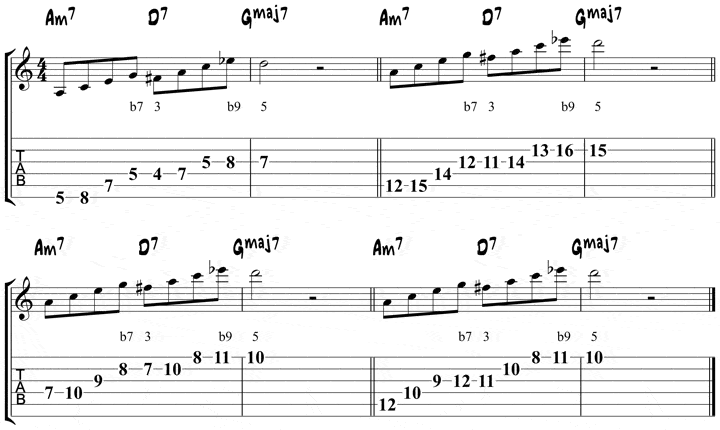
ii V I Arpeggio Pattern Solo
To help you take this concept from the page to the fretboard, here is a sample solo written out over the first 8 bars of the classic Wes Montgomery tune Four on Six.
Here, you can see the pattern applied to the non-resolving ii Vs in the second four bars of the phrase, with the first four bars being built from common minor 7 lines.
When applying this ii V arpeggio pattern to your solos, altering the rhythm is a great way to make this idea as musical as possible and not sound repetitious. You will notice that I’ve altered the rhythm in every bar of the phrase, sometimes adding new rhythmic durations such as triplets, and other times leaving notes out of the phrase to create variations of the line that still outlines the voice leading, but doesn’t become predictable in nature.
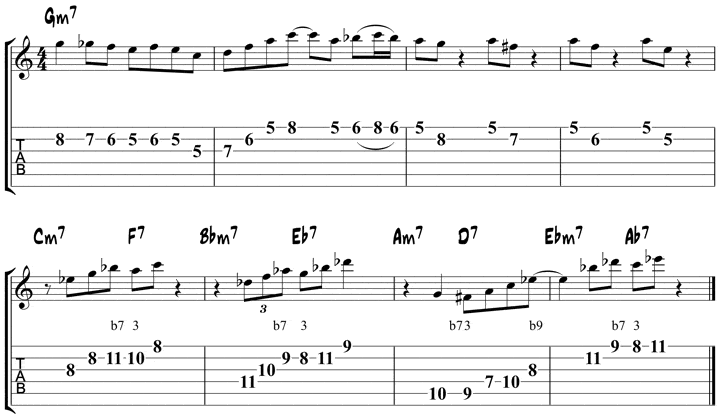
II V I Lick 9 – Larry Coryell
Here is a 2-5-1 lick in the style of Larry Coryell.
One thing that many jazz guitar masters excel at is knowing when to be fancy, and when to lay down a diatonic lick, and Larry Coryell knows just when to do this in his playing.

II V I Lick 10 – Larry Coryell
In this ii V I lick in the style of Larry Coryell, a melodic pattern is played at the start of the line, before being repeated a 1/2 step lower immediately afterward.
Coryell enjoys working chromatic patterns such as this in his lines.
Listen & Play

II V I Lick 11 – Ed Bickert
Here is a typical Ed Bickert lick that uses repeated notes and mostly diatonic note choices to build interest over a ii V I progression.
As well as featuring repeated notes in the first bar and a half of the lick, there are a number of syncopated notes in the second and third bar that raise interest levels.
From there, Ed uses a blue note on beat two of the last measure to bring a bit of chromaticism to the end of the line.
One of the coolest parts of Ed Bickert’s soloing is that he proves time and again that you don’t have to use outside or chromatic concepts to create great lines. Those options are there, but sometimes a solid inside line is just what you need to get the job done.

II V I Lick 12 – Ed Bickert
This single-note lick brings to light another classic Bickert soloing concept, playing across the neck. Ed Bickert’s signature soloing sound is often defined by his ability to play on one or two strings across the neck, rather than up a shape in a position.
In this lick, you’ll start on the second fret of the first string, and then work up to the 10th fret, covering a lot of diatonic and chromatic notes in between.
Fingering can be tricky when playing across one string, such as in the second half of this lick. Because of this, experiment with as many fingerings as you need until you find one that works for you.

II V I Lick 13 – John Abercrombie
This lick in the style of John Abercrombie uses altered notes over the A7 chord, as well as a lower neighbor tone over Em7 and a Lydian scale over Dmaj7.
Playing Lydian over a Imaj7 chord, such as in this line, is a cool-sounding way to bring a new color to your major chords, as well as bring a bit of Abercrombie to your lines.

II V I Lick 14 – Jimmy Raney
This lick in the style of Jimmy Raney is built entirely from one commonly used jazz guitar scale fingering (in this case, a G major scale in the 10th position).

II V I Lick 15 – Emily Remler
The first bar of this Emily Remler lick uses a D major 7 arpeggio which is a common substitute for Bm7. Playing a Dmaj7 arpeggio instead of a Bm7 arpeggio gives us a richer sound because of the 9 (C#, the 7 of Dmaj7).
The rest of the lick Emily uses a rhythmic idea which she transposes harmonically.

II V I Lick 16 – John Scofield
In this John Scofield-inspired lick, there are a few triads being superimposed over the underlying chords to create interest at various points in the phrase. Using triads from the 5th of any chord is a great way to highlight the 9th of that chord while not relying on the root in your phrases.
- The first is the Em triad over Am7 in bar one, which outlines the 5-7-9 intervals of that chord.
- The second is the A diminished triad over D7 in bar 2, this time highlighting the 5-7-b9 intervals of that chord.

II V I Lick 17 – Jim Hall
This major ii V I lick uses a common rhythmic device that is found in many of Jim Hall’s classic jazz guitar solos.
Here you will find a number of off-beat notes in the first two bars of the riff, that then resolve rhythmically into more straight 8th-notes in the last half of the lick.
Using displacement to start a line, and then ending the line with more static rhythms, is something that stands out in Jim’s playing, and gives him that rhythmic edginess that is characteristic of his soloing lines.
Listen & Play Along

II V I Lick 18 – Jim Hall
One thing that Jim Hall loves to do in his single-line solos is double up on notes, especially in 3rds.
In this example, you can see a line built with these ideas in mind, repeating notes that move around in diatonic 3rds over a ii V I chord progression in the key of D Major.
Also note that the pattern starts on the & of 1, something that Jim does a lot, which helps displace the pattern and make it sound more musical and less like a static pattern down a scale.
Listen & Play Along

II V I Chord Licks
In this section, you will learn to play 7 different comping and chord soloing examples of II V I progressions in the style of legendary Jazz guitarists Ed Bickert, Wes Montgomery, Joe Pass, and Jim Hall.
After playing through the lesson you will not only have 5 new chord licks to add to your jazz vocabulary but a better understanding of how to approach II V Is with creative chord choices.
ii V I Chord Solo Lick 1 – Ed Bickert
The first lick you will play through is a chord solo example from the great Canadian jazz guitarist, Ed Bickert.
If you haven’t listened to Ed Bickert’s playing before, certainly check him out. In listening to him for only a few minutes, you’ll hear his masterful sense of harmony.
Ed’s chordal playing is known for smooth voice leading, counterpoint, and use of smaller chord voicings.
The chord lick below includes examples of voice leading, as well as the usage of a few smaller chord voicings.
Listen to the recording of this chord lick to get an idea of how the exercise is played. Once you have the chord solo under your fingers, practice playing it over the included backing track.
Backing Track
Listen & Play Along

You’ll notice that in this chord solo, a few 3-note voicings are used. It’s not always the size or complexity of a chord voicing that makes the best music. Placing 3-note chord voicings with care and thoughtfulness can be one of the most musically satisfying approaches to chord solos.
Included below are notable chords used in the Ed Bickert chord solo excerpt. Check the chords out individually so that you may begin to incorporate them into your own playing.
The Gm13 Chord
On beat 2 in bar 1 of the Ed Bickert excerpt, a Gm13 chord is played:
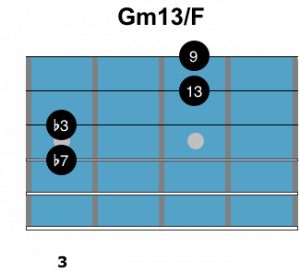
The Gm13 is always a great choice to use as a substitution for a Gm7 chord. With a bass player present, you’ll hear the added color this Gm13 chord brings to your playing.
A fully voiced Gm13 chord contains the following chord tones:
| Gm13 | G | Bb | D | F | A | C | E |
|---|---|---|---|---|---|---|---|
| 1 | b3 | 5 | b7 | 9 | 11 | 13 |
There are two main reasons why some of the chord tones are left out when playing a Gm13 chord.
- The first reason is that a 6-string guitar can only play 6 notes simultaneously, making a 7-note chord impossible.
- Secondly, in order to add character and a unique sound to each chord, certain chord tones are left out.
When dealing with chord extensions, it’s common to leave out the 5th and root of a given chord, such as in the Gm13 chord. The 5th and root are often excluded because they don’t provide as much definition or color to the chord as the 3rd, 7th or extensions.
The Gm11 Chord
On the ‘and’ of 4 in bar 1, another variation on a Gm7 chord is featured. This time, the Gm11 is played instead of Gm13. As with the Gm13, the Gm11 is another great color chord to include in your playing.
In this voicing, the 3rd and 7th are excluded from the chord. This Gm11 chord functions as a passing chord to the C7#5 in bar 2, which is why you can get away with excluding the 3rd and 7th of the chord.
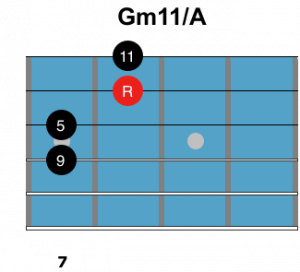
The exact notes in a fully voiced Gm11 chord are:
| Gm11 | G | Bb | D | F | A | C |
|---|---|---|---|---|---|---|
| 1 | b3 | 5 | b7 | 9 | 11 |
C7#5 Chord
The C7#5 chord in any inversion is an excellent way to add even more tension to a dominant chord in a chord progression. On the ‘and’ of 1 in bar 2 in the Ed Bickert chord excerpt, C7#5 is used as a substitution for C7.
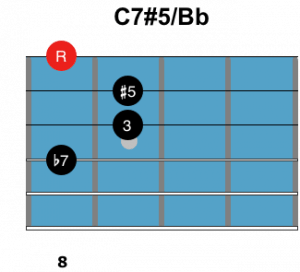
It’s important to remember that if you’re playing exclusively with a bass player, you’re basically free to use any chord substitutions.
However, if you find yourself playing with other chordal players, use extra caution when adding in dissonant voicings as substitutions.
The exact chord tones of the C7#5 chord are listed below and are used in entirety here:
| C7#5 | C | E | G# | Bb |
|---|---|---|---|---|
| 1 | 3 | #5 | b7 |
The Fadd9 Chord
Finally, the Fadd9 chord is the very last chord featured in this II V I chord solo excerpt. This rootless Fadd9 voicing is a great way to add a simple dash of color when the bass player is covering the root note.
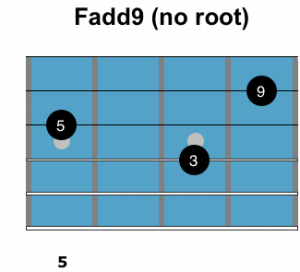
The exact spelling of an Fadd9 chord is listed below. In this example voicing, the root is excluded.
| Fadd9 | F | A | C | G |
|---|---|---|---|---|
| 1 | 3 | 5 | 9 |
Chord Lick 2 – Ed Bickert
In this chord soloing lick in the style of Ed Bickert, you’ll use three-note chords as well as one four-note chord, as you navigate the changes.
- You’ll see a II7 chord in bar two of the line, a common sub for the iim7 chord in a ii V I progression.
- There’s a V7b9 chord that’s used to create a bit of tension over the V7 chord that’s then resolved to the Imaj7 chord at the end of the line.
Listen & Play Along

Chord Lick 3 – Ed Bickert
This lick is another chord line that uses four-note chord shapes, as well as an open string, in a typical Ed Bickert style.
You’ll notice the parallel use of the m11b5 chord shape, used to outline both the Em7b5 and A7alt chord changes in the line.
This is a famous jazz guitar chord shape and one that many players use to outline both the iim7b5 and V7alt changes in a minor ii V I chord progression.
Listen & Play Along

Ed Bickert Solo Study – Song for My Father
To finish your study of these classic Ed Bickert licks, here is a sample solo over the chord changes to Song for My Father.
Start slow, go one phrase at a time, then when you’re ready you can bring each phrase together in your studies to play the solo as a whole.
Backing Track
Listen & Play Along
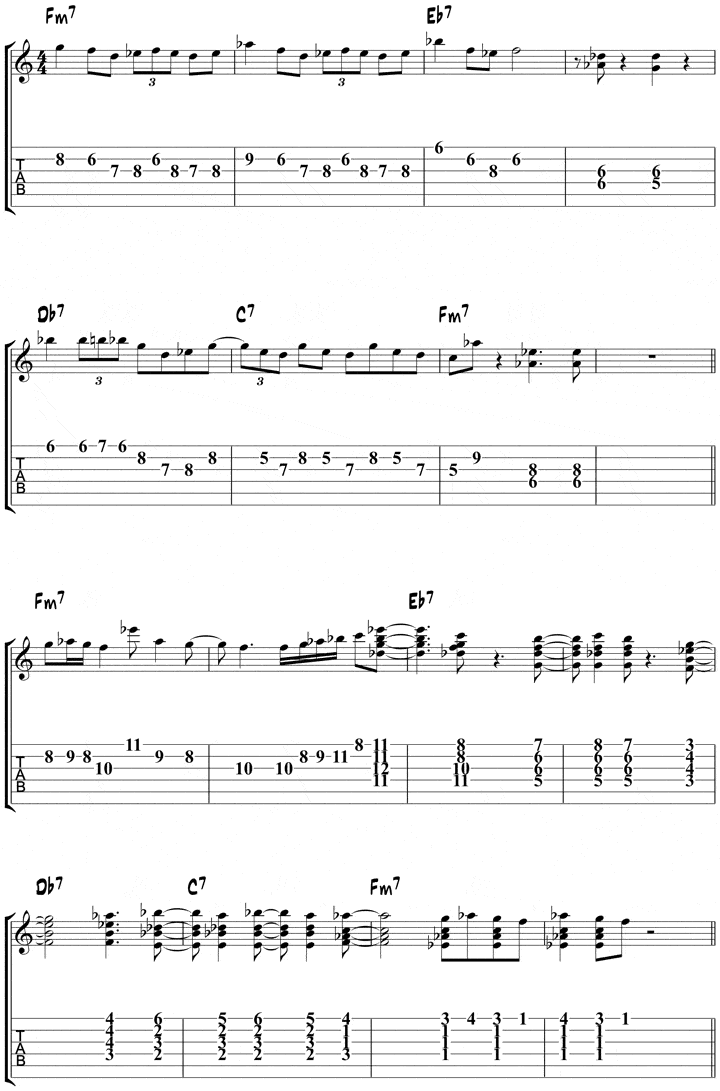
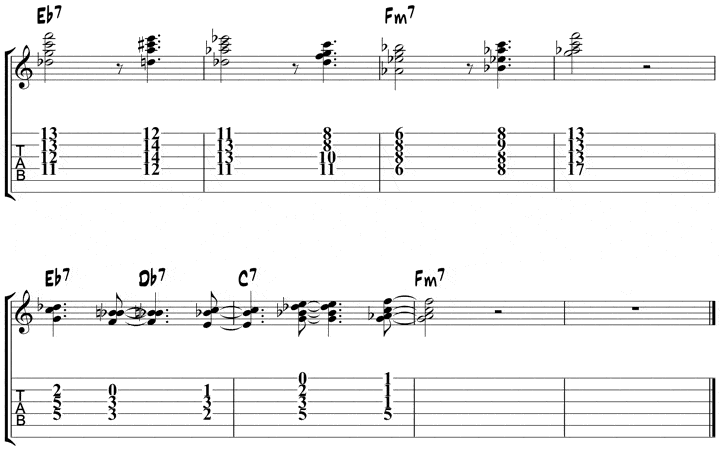
ii V I Chord Solo Lick 4 – Wes Montgomery
Wes Montgomery comped and played chord solos like no other Jazz guitarist. His chord vocabulary isn’t considered the largest, but the way he used chords was unlike anyone else.
In this Wes Montgomery solo example, you’ll play through a II V I progression in Bb major.
Backing Track
Listen & Play Along

In the above example, you’ll notice a number of stock drop 2 chords and inversions. However, a great melody line is created nonetheless.
A few of the drop 2 chords used in this II V I lick are important substitutions as well.
The Cm9 Chord
On beat 1 of bar 1, an Ebmaj7 is played over the Cm7. Why is that?
Well, Ebmaj7 contains chord tones Eb, G, Bb, and D.
Over a Cm7, Ebmaj7 ends up providing the b3, 5, b7, and 9th:
| Ebmaj7 | Eb | G | Bb | D |
|---|---|---|---|---|
| Over Cm7 | b3 | 5 | b7 | 9 |
Here is the Cm9 chord shape. Remember that this chord shape can be used as an Ebmaj7 (technically in 2nd inversion) or as a Cm9 chord.
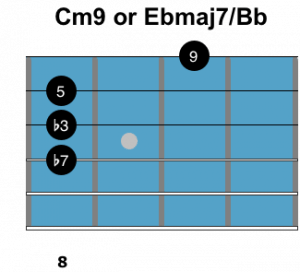
The F9 Chord
The second important chord substitution from this excerpt is Am7b5 used over the F7 in the second half of bar 2.
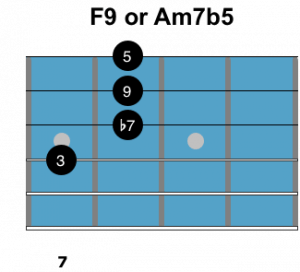
Using an Am7b5 over F7 provides the 3, 5, b7, and 9 of the F7 chord:
| Am7b5 | A | C | Eb | G |
|---|---|---|---|---|
| Over F7 | 3 | 5 | b7 | 9 |
The Bb6 Chord
The last notable chord substitution in this excerpt can be found in bar 3.
Instead of playing a Bbmaj7 chord note for note, a Gm7 chord is found.
Using a Gm7 chord over Bbmaj7 doesn’t provide the 9 like the other chord substitutions did, but provides the 6 instead.
When using the Gm7 over Bbmaj7, the 7th of the Bbmaj7 is completely excluded in favor of the 6, which gives the chord another unique color.
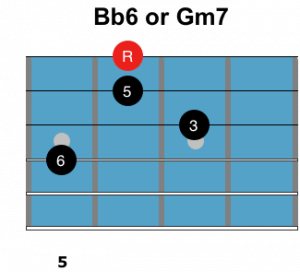
Playing a Gm7 chord over Bb yields the following notes:
| Gm7 | G | Bb | D | F |
|---|---|---|---|---|
| Over Bb | 6 | 1 | 3 | 5 |
ii V I Chord Solo Lick 5 – Joe Pass
This next comping example is borrowed from the musical styling of Joe Pass.
Backing Track
Listen & Play Along

The C13#9 Chord
The first thing you may notice about this excerpt is that the C13#9 chord is played in the place of Gm7.
Joe Pass often played solo, which would give him the freedom to add additional chords or forego them completely.
In this example, in combination with a C pedal, Joe plays variations of the V7 chord until resolving to an Fmaj6/9 chord at the end of bar 2.
Both of the variations of the V7 chord are excellent chords that can be used in both group and solo settings. Using these 2 V7 chords in conjunction with each other also works great as an intro for a given tune.
Here are the chords:
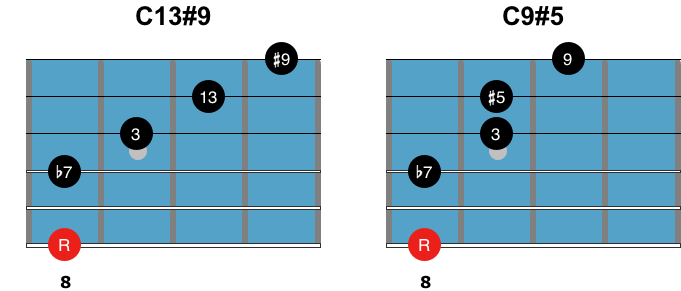
A complete C13#9 chord is spelled (in our C13#9 voicing, the 5 and 11 are excluded):
| C13#9 | C | E | G | Bb | D# | F | A |
|---|---|---|---|---|---|---|---|
| 1 | 3 | 5 | b7 | #9 | 11 | 13 |
In its entirety, the C9#5 chord is spelled:
| C9#5 | C | E | G# | Bb | D |
|---|---|---|---|---|---|
| 1 | 3 | #5 | b7 | 9 |
For this II V I chord lick, no C9#5 chord tones are omitted.
If you’d like to use the two above chords as an introduction, try vamping between them just like in the first 2 bars of the original Joe Pass excerpt.
ii V I Chord Solo Lick 6 – Jim Hall
In this next musical excerpt, you will comp through a II V I progression in the style of Jim Hall.
Jim Hall helped define and push the limits of contemporary jazz guitar with his incredible creativity and musical sensibility.
In playing through this example, you will notice a pattern of dissonant chord voicings followed by consonant chord voicings.
This excerpt itself is a microcosm of an important approach to jazz harmony: the concept of maintaining a persistent cycle of tension and resolution through chord progressions and melodies. The more jazz harmony you play, the more you’ll recognize these patterns of tension and resolution.
Backing Track
Listen & Play Along

This comping excerpt shows an interesting progression of chords through a II V I progression in Bb major.
In the following sections, you’ll play through each notable chord and find out what makes them special.
The C7b9#9 Chord
The example starts with a Cm7 chord before shifting to a type of C7 chord on beat 3 of bar 1.
Instead of playing typical drop chord voicings, Jim often played voicings unique to his playing style. The chord on beat 3 of bar one is an excellent example of the unique voicings Jim would employ in his playing.
The chord itself is a rootless C7b9#9 chord.
A C7b9#9 chord is spelled the same way as a C7 chord with the addition of the b9 and #9 tones.
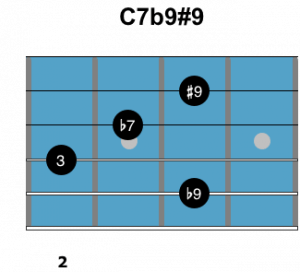
| C7b9#9 | C | E | G | Bb | Db | D# |
|---|---|---|---|---|---|---|
| 1 | 3 | 5 | b7 | b9 | #9 |
This C7b9#9 chord voicing can be played over any dominant 7th chord to create additional harmonic tension.
The F6 Chord
Another notable chord in this comping excerpt is the F6/C chord on beat 1 of bar 2. In this F6 voicing, no chord tones are omitted.
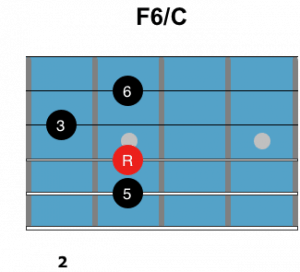
Additional consonance is created when resolving to any kind of 6 chord, especially if the chord was meant to be a dominant 7th chord to begin with.
| F6 | F | A | C | D |
|---|---|---|---|---|
| 1 | 3 | 5 | 6 |
ii V I Chord Solo Lick 7 – Jim Hall
For the last chordal II V I example in this lesson, you’ll take a look at another Jim Hall inspired lick.
This excerpt is a rather fun, outside and somewhat quirky approach to playing a II V I progression.
Using only 1 chord shape, you’ll play through a complete II V I progression in G major.
Backing Track
Listen & Play Along

The C#aug Triad
So, what is the chord shape? The single shape used in this lick is an augmented triad.
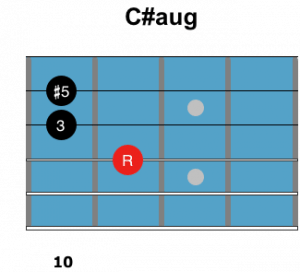
Augmented triads are a great tool for quickly getting an outside sound in your playing. The C# augmented triad is spelled:
| C#aug | C# | E# | G## |
|---|---|---|---|
| 1 | 3 | #5 |
- In bar 1, the two augmented triads played a whole step apart (C#aug and Baug) create a whole tone scale vibe, and also produce the root, 3, b5, #5, 7 and 9 over an A bass note. Please note that throughout this lick, the lowest note in the 2nd augmented triad is omitted (in this case the B or chord 9th). However, when you play the lick, simply slide the same shape back and forth as if you were going to play the complete augmented triad. In this situation, it’s quick to see that an altered dominant 7th chord is the theme of each passing bar in the lick. This is a very accessible and fun lick to play, but it’s important to remember that if you’re playing with another chordal player or soloist, this lick can easily step on other’s toes.
- Moving on to bar 2, the exact same lick is played down a half step with Caug and Bbaug. Over a D7 chord, Caug and Bbaug provide the exact same chord tensions as in the first bar (1, 3, b5, #5, 7, and 9).
- Instead of playing a Gmaj7 in bar 3, the same relative pattern of augmented chords is played using Baug and Aug, which creates the same relative chord tensions: 1, 3, b5, #5, 7, and 9.
A Few Parting Tips…
In conclusion, here are a few important ideas from these licks that you can take to the woodshed (aside from the licks and chord shapes themselves).
1) Melody: in a number of the licks you just played through, melodies were formed through the careful selection of chords. Try to incorporate melody into both your comping and chord soloing when practicing chord progressions or full tunes.
2) Smooth Voice leading: in every example included in this lesson, you’ll notice that when shifting from bar to bar and consequently chord quality to chord quality, very little note movement occurs. Voice leading is a lifelong study, but it’s never too early or too late to start incorporating its concepts into your playing. Start by finding the closest possible voicing when progressing from chord to chord.
3) Finally, be creative! Search for new voicings, take chances with your chords and find what works for you and your ear.
More Jazz Guitar Licks



Is it my computer or is this website having problems with the audio tracks breaking up?
Really enjoyed this – thank you both. Is there a way that I can print the article and then download the tracks with one click or is that too optimistic?
David
This is great!!! Thank’s a lot.
Hi Terrence, very good voicing indeed and helpful lesson.
I like the backing track also – is it build with BIAB ? If yes can you share which style is used for ?
Cheers
Pierre
Yes Pierre, backing tracks are done in Band in a Box, I think the Jazz Swing Piano Trio style…
In the example ‘On beat 4 in bar 1’ why is a chord Gmm 11/A? if it does not the Bb note that characterizes the minor tone of a chord
Hi Urbano, indeed, the b3 characterizes a minor chord, but you don’t have to voice all notes of a chord…
hi guys check out ed bickert with lorne lofsky CD’S. Lorne is another Toronto guitarist, Music Professor and he recorded and toured with Oscar Peterson! Lorne is very respected buy other Jazz players/teachers and should not be missed. You may also like the wonderful Rob Piltch. (played with BS&T and has recorded with many artists. Toronto Monsters of the guitar, for sure.
Do you recommend playing the Bb6 (lick 2) with four fingers or barring the first and second string with your middle finger? Barring feels a little awkward at first but I imagine it’s helpful to free up the pinky
good stuff,very helpful
The most remarkable feature of the Ed Bickert example is then unremarked blunt-force landing on the FMaj9#11 by redefining the C7sus shape which precedes it.
This has met me exactly where I can use and have fun with the different examples; Thank you.
thanks a lot for sharing this!i’m looking excited to upply inmy new compings…
I loved the Jim Hall examples! Give us some more!
Great material! Sincere thanks for sharing this…
Challenging advanced stuff….thanks a lot!
Clean and precise, great job like usual…
Fantastic, thank you dearly
Ed Bickert,Was a wonderful player melodic,great chord solos and melody love to hear more from him in upcoming lessons,Vincent.
….Ed was a great player and since BET television is off the air ,I cant find any videos of him ,…..do you know of any….thanx
Can’t imagine that you would not have searched on youtube. Lots of great videos there.
Loved the Ed Bickert lesson. Glad to see you turning people on to him.
Tasty? Yes.
Smooth? Yes.
Interesting? Yes.
Worthy of study? Yes.
Should be ranked with Wes and Joe? Absolutely not !!!
Too many cliches and obvious scale sequences.
Obviously a very good player, but I reserve the word “great” for players that don’t have the same faults as me.
Hey, thanks. Check out the explanation above the lick, it explains the Db7 chord used as a sub over Gm7.
The first is the tritone sub in bar one of the progression, I this case it’s the Db7 over Gm7 that resolves to C7 in the second bar of the line. Normally a tritone sub would be played over the V7 chord in a ii V I, but you can also tritone the iim7 chord. When doing so, you’ll commonly find a 7th chord used in place of a m7 chord to create a stronger resolution to the V7 chord at that part in the phrase.
Great lesson, as usual!
Thanx
Hey guys great lessons as always, I have Pure Desmond which is bulletproof and tasteful Ed, what are some of the top five discs that encapsulate best his playing?
Thanks, I’m not sure if I could name a top 5, I don’t think Ed has any bad records, so I think you’re safe exploring any of his recordings.
I own and enjoy the Paul Desmond Quartet Live. Recorded live at Bourbon Street, Toronto, Canada in 1975, it’s about 79 minutes of Desmond in a very intimate setting (small crowd), with Bickert on guitar, Jerry Fuller on drums, Don Thompson on upright bass. This was the release that really made me be aware of and appreciate Bickert. This was so plainly a no-pressure, take-your-time gig, and listening to it, for me at least, is good medicine, and inspirational to me as a guitarist. It was originally released as a double LP, now available on CD or as an MP3 DL.
Nice compliment to a great musician. To get more of his wok listen to Boss Brass recordings or Bickert with bassist Don Thompson. Here’s another one to write about or get to know; Louis Stewart ex of George Shearing’s group.
Davvero interessante, come sempre. Grazie Matt.
Matt, thanks for this insight into Ed Bickert’s style ,very useful
Compliments of the Season to you and Dirk
Thank you!!!! I agree as much as respect JP Wes.This guy deserves some recognition.Maybe this is the beginning.
Great lesson – excellent ideas, with an interesting ‘strangeness’ to them that makes me want to check out this guitarist I don’t know. Thanks for putting me on to him, and the great lesson.
Thanks for posting this Matt. Ed is one of my favourite guitarists and the reason I got started [recently] working on jazz guitar. Even bought a tele just because! 🙂
Big thanks, I just discover d Ed a few days ago, what a great great player, he reminds me of Jim Hall in some ways, but yet, I find him a better player……all around!
Just flat out fun. All these are. I appreciate the promoting just the music. Inadvertently restoring the dignity and legitimacy of this powerful force known as music. That goes for the entire site.
Glad you are digging it Kevin. The fingerings are suggestions to get you started, so if you find a different one that you like go ahead and check it out. As with most things on guitar, there are a few or more ways to work out fingerings for this exercise on the neck. So go for it!
Meant to ask, the 1st time around:
Are there any common songs this turnaround appears in, that you can think of?
Kevin